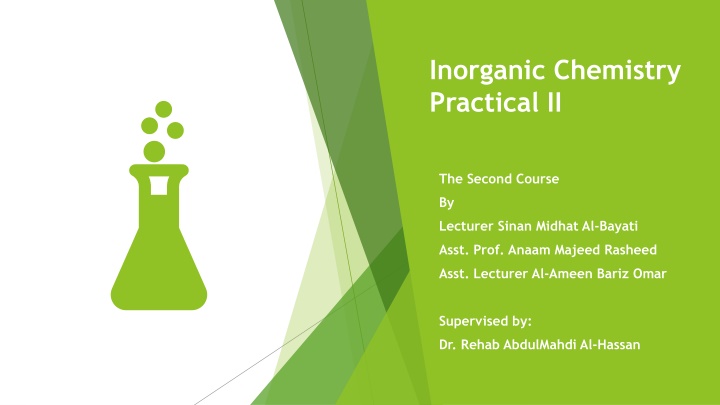
Preparation of Cuprous Oxide Experiment Guide
Dive into the practical world of inorganic chemistry with this detailed experiment guide on the preparation of cuprous oxide. Learn the procedure, reagents used, equations involved, and answer key questions to deepen your understanding of this fascinating process.
Download Presentation

Please find below an Image/Link to download the presentation.
The content on the website is provided AS IS for your information and personal use only. It may not be sold, licensed, or shared on other websites without obtaining consent from the author. If you encounter any issues during the download, it is possible that the publisher has removed the file from their server.
You are allowed to download the files provided on this website for personal or commercial use, subject to the condition that they are used lawfully. All files are the property of their respective owners.
The content on the website is provided AS IS for your information and personal use only. It may not be sold, licensed, or shared on other websites without obtaining consent from the author.
E N D
Presentation Transcript
Inorganic Chemistry Practical II The Second Course By Lecturer Sinan Midhat Al-Bayati Asst. Prof. Anaam Majeed Rasheed Asst. Lecturer Al-Ameen Bariz Omar Supervised by: Dr. Rehab AbdulMahdi Al-Hassan
Experiment No. (5) Preparation of Cuprous Oxide:
Copper (I) oxide or cuprous oxide is the inorganic compound with the formula Cu2O. It is one of the principal oxides of copper. This red- coloured solid is a component of some antifouling paints. The compound can appear either yellow or red, depending on the size of the particles.[2] Copper (I) oxide is found as the reddish mineralcuprite. The Required Reagents: 1.Copper sulfate hydrous CuSO4.5H2O (0.5 gr). 2.Sodium sulfate Na2SO3 (0.75 gr). 3.Sodium chloride NaCl (0.5 gr). 4.Borax (0.5 gr). 1.Distilled water
Procedure: Dissolve (0.5 gr) of CuSO4.5H2O in (5 ml) of distilled water in a beaker. Dissolve (0.75 gr) of Na2SO3and (0.5gr) of NaCl together in (10 ml) of distilled water in another beaker. Mix the two solutions in one beaker, a green precipitate will be formed and it will quickly dissolve and turns into a soluble solution. Dissolve in another beaker (0.5 gr) of borax in (10 ml) of distilled water and then boil the solution. Add the mixture of step (3) to the boiling solution of step (4) drop wise with stirring; a yellow precipitate will be formed, which will turns into a dark color with boiling continued for half an hour. After half an hour red crystals will be formed. Filter the solution using filter paper, dry the red crystals, report the yield and then calculate the percentage.
Equations: 2CuSO4.5H2O + Na2SO3 + H2O Cu2SO3 + Na2SO4 + 10H2O + H2SO4 Cu2SO3 + 6NaCl 2Na2[CuCl3] + Na2SO3 Soluble Complex Na2B4O7 + H2O NaBO2 + B2O3 Sodium Meta Borate Borontrioxide Na2[CuCl3] + B2O3 CuBO2 Unstable B2O3 Cu2O Red Crystals
Questions: What is the basic idea of this experiment? Explain. Write the balance equations of preparation of Cu2O. Why we use: CuSO4.5H2O Na2SO3 NaCl Borax Distilled water Write the structure of borax, and calculate the oxidation state of B. Give the oxidation state of S in each Na2SO4and Na2SO4. How Cu1+ is maintained?






















